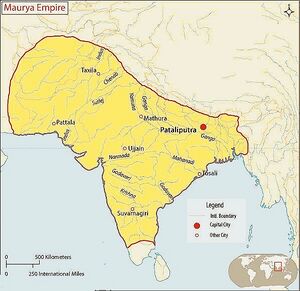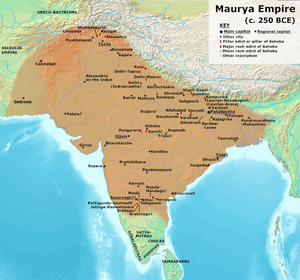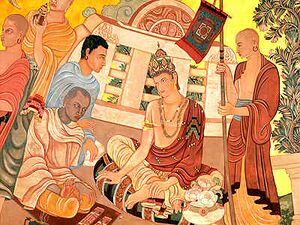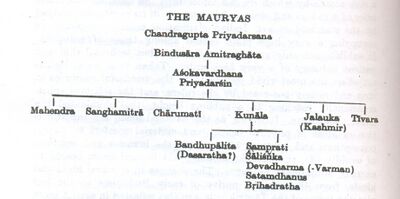Mauryan Empire
| Author:Laxman Burdak, IFS (R) |



The Maurya Empire (321BC-185BC) was the largest and most powerful political and military empire of ancient India.
Originating from the kingdom of Magadha in the Indo-Gangetic plains of modern Bihar and Bengal, and with its capital city of Pataliputra (near modern Patna), the Empire was founded in 321 BCE by Chandra Gupta Maurya, who had overthrown the Nanda Dynasty and begun expanding his power across central and western India. The Empire stretched to the north along the natural boundaries of the Himalayas, and to the east stretching into what is now Assam. To the west, it reached beyond modern Pakistan and included Baluchistan in Persia and significant portions of what is now Afghanistan, including the modern Herat and Kandahar provinces. The Empire was expanded into India's central and southern regions by Emperor Bindusara, but it excluded a small portion of unexplored tribal and forested regions near Kalinga.

Following the conquest of Kalinga in a major war, Ashoka the Great ended the military expansion of the empire. The kingdoms of Pandya and Cheras in southern India thus preserved their independence, accepting the supremacy of the Mauryan emperor. The Mauryan Empire was perhaps the greatest empire to rule the Indian subcontinent until the arrival of the British. Its decline began fifty years after Ashoka's rule ended, and it dissolved in 185 BCE with the foundation of the Sunga Dynasty in Magadha.
Mauryans and Jats
According to Ram Swarup Joon Mauryans being Jats, were denigerated by Brahmans and were termed even Shudras to show their cotempt. Infact Maurya was not a caste but it was a gotra of Jats which is still found in Jats. The existence of Khoye Maurya gotra in Jats proves that Mauryans were Jats. Gupta was a title of Chandra Gupta and not the caste, as has been proved below in the history of Chandra Gupta. He was a warrior of Jat caste. There are numerous legends about the Maurya dynasty, as Ashoka of this dynasty was an ardent follower of Buddhism, Brahmin writers have, in the Puranas, called it a Shudra dynasty.
In the list of Jat clans we find:
- Maurya (मौर्य)
- Mor (मोर)
- Mori (मोरी)
- Moriya (मोरिया)
- Morsara (मोरसरा)
- Morwa (मोरवा)
- Morwal (मोरवाल)
- Morya (मोर्या)
- [[[More]] (मोरे)
All these are Jat gotras of very old standing. Hence the rule of this dynasty has been given a high place in history of Jats.
The Jat historian Bhim Singh Dahiya published a paper titled The Mauryas: Their Identity (Vishveshvaranand Indological Journal, Vol. 17 (1979), p.112-133) in 1979 [1]and a book titled Jats the Ancient rulers (Jats the Ancient rulers, Dahinam Publishers, Sonipat, Haryana, by B. S. Dahiya I.R.S.) in 1982, wherein he concludes that the Mauryas were the Muras or rather Mors and were Jat of Scythian or Indo-Scythian origin. It is claimed that the Jats still have Maur or Maud as one of their clan name.[1]
This view may become creditable only if it is accepted that the Jatts evolved from the Madras, Kekayas, Yonas, Kambojas and the Gandharas of the north-west borderlands of ancient Indian sub-continent. This is because king Ashoka's own Inscriptions refer only to the Yonas, Kambojas and the Gandharas as the most important people of his north-west frontiers during third century BCE. They do not make any reference whatsover, to the Sakas, Shakas or the Scythians. See: Rock Edict No 5 [7] and Rock Edict No 13 [8] ( Shahbazgarhi version).
The view of Bhim Singh Dahiya that the Mauryas were Jat is supported from the fact that Khoye Maurya is clan of Jats found in Uttar Pradesh, India. The meaning of 'Khoye Maurya' is the 'lost Maurya' in Hindi language. The Khoye Maurya clan is not found in Rajputs. Moreover Madraks, Joon(Yona) and Gandharas are clans found in Jats.
The Buddhist traditions preserved in Mahavamsa describes Chandragupta as coming of Kshatriya clan of Maurya:
Mauryanam Khattyanam vamsha jata
(Geiger Trans p 27). It means "Mauryas are Kshatriyas of Jat clan".
A K Mittal in 'Political and Cultural history of India', page 126, 'Rahul Sankrityan' in 'Bauddha darshan', page 19 and Dr Atul Singh Khokhar in 'Jāton kī utpati evaṃ vistār (Jart tarangiṇī)(Origin and expansion of Jats), page 113, have mentioned with reference to Mahavansha and 'tatva prakashini' that Mauryas are kshatriyas belonging to Jat vansha.
Dr Atal Singh Khokhar[2] further writes that Chandragupta Maurya has been mentioned in 'divyadān' as under in sanskrit:
Sanskrit:- मोरियानं खत्तीयानं वंसे जातं सिरीधरं चन्द्रगुत्तोति पञ्चत चाणक्यो ब्राह्मणो ततो नवमं धनन्तं घातेत्वा चण्डकोधसा संकले जम्बूद्वीपरिह रज्ज सममिसिंचिसी
IAST:- Moriyānaṃ khattīyānaṃ vaṃse jātaṃ sirīḍaraṃ chandraguttoti pañcata cāṇakyo brāhmaṇo tato navamaṃ dhanantaṃ ghatetvā caṇdakodhasā saṃkale jambūdvīāriha rajja sammisincisī
Meaning - Chandragupta, born in Moriya kshatriya vansha, killed nine Nandas with the help of Chanakya and established his rule in entire Jambudvipa.
As per Spunar the ancestral abode of Mauryas was at 'Parshupur', who were Jatri (Jatrana) Jats of Mand Empire.
The above evidences prove that Mauryas were a clan of Jats.
Chandra Gupta (321BC-298 BC)
Chandra Gupta (321BC-298 BC) was the founder of Mauryan Empire (321BC-184 BC). We have little knowledge about the early life of Chandra Gupta. Some historians regard him as a prince of the Nanda dynasty while others try to associate him with a poor family. His mother Mura is said to belong to a low caste family. Neverthless, he held a high rank in Nanda army. Mauryans being Jats, were denigerated by Brahmans and are termed even Shudras to show their cotempt. Even historians like Romila Thapar are confused. She says –
- “Chandra Gupta belonged to the Moriya tribe, but his caste was low, the family apparently being Vaishyas. The young Mourya and his supporters were inferior in ardent strength to Nanda.”
Infact Maurya was not a caste but it was a gotra of Jats which is still found in Jats. Gupta was his title and not the caste. He was a warrior of Jat caste.
Mor, Moriya, Maurya, Maurana are Jat gotras of very old standing. Hence the rule of this dynasty has been given a high place in history of Jats.
There are numerous legends about the Maurya dynasty, as Ashoka of this dynasty was an ardent follower of Buddhism, Brahmin writers have, in the Puranas, called it a Shudra dynasty.
It has, however, been established that Maurya was an old dynasty ruling in the Northern Hills. King Padmananda of the Nanda Dynasty failed in his efforts to conquer this State. Ultimately, his wily minister Shaktar succeeded where Padmananda had failed. As a result of a clever conspiracy the whole ruling family was killed except one pregnant queen who escaped and started living in Magadha as a beggar. One night she delivered a boy and put him in a garbage heap in front of a potter's house. When the potter's wife heard the child's cry, she came out and saw that the boy was handsome as a moon. She took him in her care and named him Gupta Chandra i.e. hidden moon. His mother resolved to rein the Mauryan kingdom one day. She got a job as a maid in the palace so that she could remain in touch with the affairs of the State, She, also kept an eye on her son who displayed signs of greatness.
The Sheshnaga rulers who earlier had their capital at Rajgiri, shifted to Patliputra on the confluence of Rivers Ganga and Sone. The ambitions Nanda killed their last ruler and annexed the State. Nanda also conquered the Kaushal kingdom.
At this stage Nanda grew suspicious of his minister Shaktar, son of Viktar. After accusing him of some fictitious offence he got him imprisoned in a dry well.
One day King Nanda happened to laugh. The maid who was attending on him also laughed. The king, considering her action impertinent, sentenced her to death. He however agreed to pardon her if she could tell why he had laughed. At night she went to the dry well and gave food and water to the starving Shaktar. He was grateful and on hearing of her problem, gave her the correct answer. She repeated it to the king the next morning. The king was surprised and asked her how she found the right answer. She told the truth. The king was impressed and ordered Shaktar to be released and reinstated. Shaktar, however, never forgave him and started plotting his destruction.
Vishnu Gupta, well known as Chanakya or Kautilya was educated at the University of Taxila. He was learned but ugly. One day a shoot of spear grass pricked his foot. He said aloud that he would destroy the grass. Shaktar who happened to be passing by told him not to worry, as he would get it destroyed by royal servants. The two became friends after that.
Once Chanakya had gone to a feast given to Brahmins by Nanda on his father's death anniversary. Nanda could not stand Chanakya's ugliness and got him thrown out. Thus Chanakya was harboring a grudge against Nanda. He started looking for some one whom he could train to be capable of destroying Nanda. One day he spotted Chandra Gupta holding a mock-up court of a group of shepherds. He asked him some questions and was impressed by his intelligent answers. Chanakya took Chandra Gupta in his care and trained him so well that with the connivance of Shaktar he became Nanda's C-in-C. He became very popular. Unfortunately the conspiracy leaked out and Chandra Gupta and Chanakya were banished from the country. They migrated to Punjab. At the time of Alexander's invasion they managed to get a number of small states to get together and marshaled a sizeable army under the command of Chandra Gupta. He defeated Alexander's General Seleucus who gave him his daughter Helen in marriage and retired to Greece. Chandra Gupta became the ruler of most of the Punjab with Chanakya as his Prime Minister. Chandra Gupta conquered Magadha thus fulfilling Chanakya's long cherished aim of destroying Nanda.
Bindusara (298BC-272BC)
Bindusara (298BC-272BC) was son of Chandra Gupta Maurya and King of Mauryan Empire. After Chandra Gupta’s death his son Bindusara ascended to throne of Magadha, in 298 BC. Sufficient historical evidence is not available regarding his reign. He had assumed the title of ‘Amitraghata’ or the slayer of foes. Therefore it sounds that like his father he was also a conqueror. During his rule the governor of Taxila rose in rebellion which was crushed by his son Ashoka. Bindusara ruled for 25 years before he died in 273 BC.
Maharaja Ashoka (304BC-232BC)
Ashoka (304BC-232 BC) was son of Bindusara and a very capable ruler and administrator of the Mauryan Empire. He ruled from 273 BC - 232 BC. He was the third and the most popular of the Mauryan Kings. He was born in about 302 BC. During his father’s reign he had served as the governor of Taxila and Ujjain which had given him enough experience as an administrator. He succeeded to the throne after his father’s death in 273 BC.
After the massacre at Kalinga in, in 261 BC, he felt deep remorse and became a follower of Buddhism. He had built up a larger empire than any ruler before him had. He contributed a great deal to the expansion of Buddhism. His son and daughter became Bhikshus for the propagation of Buddhism. Unfortunately his successors were not capable. His son Kunal was blind. His grandsons Dashratha and Sam Vrate were weak. Pushyamitra, a minister, killed the last Maurya ruler and usurped the throne. This Brahmin ruler was very cruel. He embarked upon mass persecution of Buddhists. According to the book Dev Vidhan he awarded 100 Dinars to any one producing a head of Buddhist monk. His dynasty ruled for 112 years till another Brahmin named Kanva whose descendants ruled for another 45 years killed its last ruler.
Satvahanas and Andhra Brahmins against Shaka Kshatriyas who were followers of Buddhism carried out similar persecutions.
Dasarath Maurya (232BC-224BC)
Dasaratha Maurya was the king of the Mauryan Empire from 232 B.C. to 224 B.C. He was the successor of Ashoka the Great.
Samprati Maurya (224BC-215BC)
Samprati Maurya was king of the Mauryan Empire from 224-215 BCE. He was the successor of Dasaratha Maurya.
Salisuka Maurya (215Bc-202BC)
Salisuka Maurya was king of the Mauryan Empire from 215-202 BCE. He was the successor of Samprati Maurya.
Devavarman Maurya (202BC-195BC)
Devavarman Maurya was king of the Mauryan Empire from 202 - 195 B.C.E. He was the successor of Salisuka Maurya.
Satadhanvan Maurya (195BC-187BC)
Satadhanvan Maurya was a king of the Mauryan Empire. He ruled from 195-187 BCE. He was the successor of Devavarman Maurya.
Brihadrata Maurya (197BC-185BC)
Brihadrata was the last ruler of the Indian Mauryan dynasty. He ruled c.197 - 185 B.C.E.
Maurya territories, centered around the capital of Pataliputra, had shrunk considerably from the time of the great Emperor Ashoka when Brihadrata came to the throne.
He was killed in 185 BCE and power usurped by his commander-in-chief, the Brahmin general Pusyamitra Sunga, who then took over the throne and established the Sunga dynasty.
In 180 BCE, northwestern India (parts of modern day Afghanistan and Pakistan) were attacked by the Greco-Bactrian king Demetrius. He established his rule in the Kabul Valley and parts of the Punjab in modern-day Pakistan. His successors would later engage in a series of wars with the Sungas.
See also
Jats the Ancient Rulers (A clan study)/Porus and the Mauryas - Book by Bhim Singh Dahiya, IRS, which provides evidences of visible links of Mauryas with Jat history.
External links
Further reading
- Ram Swarup Joon: History of the Jats, Rohtak, India (1938, 1967)
- Dr Natthan Singh: Jat - Itihas (Hindi), Jat Samaj Kalyan Parishad Gwalior, 2004
- RN Kundra & SS Bawa, History of Ancient and Meddieval India
References
- ↑ Dehiya on the Jat Iranic identity of Mauryas:History of Iran
- ↑ 'Jāton kī utpati evaṃ vistār (Jart tarangiṇī)(Origin and expansion of Jats), p.139
Back to History Back to Jat Kingdoms in Ancient India

